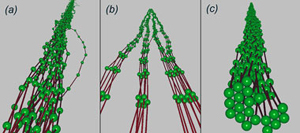Home > Press > How to Braid Nanoropes
Abstract:
Max Planck scientists identify essential control parameters for the assembly of filament bundles
How to Braid Nanoropes
October 14, 2005
Biomimetic systems that are composed of rigid polymers or filaments and crosslinking molecules can be used to assemble filament networks and bundles. The bundles represent `nanoropes' and exhibit material properties that are primarily determined by the number of plaited filaments. Scientists at the Max Planck Institute of Colloids and Interfaces in Potsdam, Germany have now shown that this assembly of filaments into bundles is prevented by the thermal motion of the filaments, unless the crosslinker concentration exceeds a certain threshold value. The latter value depends on the number of filaments, but remains finite in the limit of a large filament number. As the crosslinker concentration is lowered, the bundles may segregate into small sub-bundles, or undergo abrupt unbinding transitions. (Physical Review Letters 95, 038102, July, 2005).
Biological cells are mechanically stable because they contain actin filaments and microtubules that form networks and bundles. These filament architectures are determined and controlled by crosslinking proteins, which have two sticky ends that bind to different filaments. In order to understand the underlying forces and to optimise the mechanical properties of these architectures, one must study biomimetic model systems that are solely composed of filaments and crosslinking proteins. One important example is the assembly of several filaments into thick bundles or ‘nanoropes’ that are more rigid, and sustain a larger external load, than single filaments.
The assembly of filaments by molecular crosslinkers is disturbed by the thermal motion of the filaments. Scientists at the Max Planck Institute of Colloids and Interfaces have now shown that this thermal motion prevents filament assembly unless the crosslinker concentration exceeds a certain threshold value. The latter value depends on the filament rigidity, on the binding energy of the crosslinkers, and on the temperature. Furthermore, the threshold value decreases as the number N of filaments within the bundle is increased, but remains finite in the limit of large N.
Snapshots of filament bundles as observed in computer simulations are displayed in Fig. 1. The snapshot in Figure 1(a) shows a loose bundle for a crosslinker concentration only slightly above the threshold value. The simulations also reveal that these bundles do not always reach their equilibrium shape, but often segregate into sub-bundles containing typically five filaments as shown in Figure 1(b). This bundle morphology differs strongly from the fully equilibrated bundle shape as shown in Figure 1(c) for the same system. Which of the two morphologies is attained depends on the initial arrangement of the filaments and on the kinetics of the assembly process.
Biomimetic systems, consisting of solutions of actin filaments and crosslinking proteins, have also been studied experimentally by several research groups. The available experimental data is consistent with the new theory based on the interplay of molecular crosslinkers and thermal motion. In particular, there is some experimental evidence for the threshold concentration of crosslinkers and the sudden onset of filament bundle formation above this concentration, but systematic experimental studies remain to be done that explore the dependence on the filament number N.
Apart from representing important structural elements, filament bundles can also provide strong pushing forces. These pushing forces arise from the directed growth of the filaments by the addition of molecular building blocks. One important problem is to understand the dependence of these pushing forces on the number of filaments within the bundle. This research topic is currently being pursued within the European network on 'Active Biomimetic Systems', see related link below.
Related links:
[1] European Funding for Research on Biomolecular Nanomachines
Original work:
Jan Kierfeld, Torsten Kühne, and Reinhard Lipowsky, "Discontinuous unbinding transitions of filament bundles" Physical Review Letters 95, 038102 (2005).
Contact:
Dr. Jan Kierfeld
Max Planck Institute of Colloids and Interfaces, Potsdam
Tel.: ++49 331 567-9620
Fax: ++49331 567-9602
jan.kierfeld@mpikg.mpg.de
Katja Schulze (Press and Public Relations)
Max Planck Institute of Colloids and Interfaces, Potsdam
Tel.: ++49 331-567-9203
Fax: ++49 331-567-9202
katja.schulze@mpikg.mpg.de
Copyright © Max Planck Society
If you have a comment, please Contact us.
Issuers of news releases, not 7th Wave, Inc. or Nanotechnology Now, are solely responsible for the accuracy of the content.
| Related News Press |
Materials/Metamaterials/Magnetoresistance
![]() Nanoscale CL thermometry with lanthanide-doped heavy-metal oxide in TEM March 8th, 2024
Nanoscale CL thermometry with lanthanide-doped heavy-metal oxide in TEM March 8th, 2024
![]() Focused ion beam technology: A single tool for a wide range of applications January 12th, 2024
Focused ion beam technology: A single tool for a wide range of applications January 12th, 2024
Announcements
![]() NRL charters Navy’s quantum inertial navigation path to reduce drift April 5th, 2024
NRL charters Navy’s quantum inertial navigation path to reduce drift April 5th, 2024
![]() Discovery points path to flash-like memory for storing qubits: Rice find could hasten development of nonvolatile quantum memory April 5th, 2024
Discovery points path to flash-like memory for storing qubits: Rice find could hasten development of nonvolatile quantum memory April 5th, 2024
|
|
||
|
|
||
| The latest news from around the world, FREE | ||
|
|
||
|
|
||
| Premium Products | ||
|
|
||
|
Only the news you want to read!
Learn More |
||
|
|
||
|
Full-service, expert consulting
Learn More |
||
|
|
||









